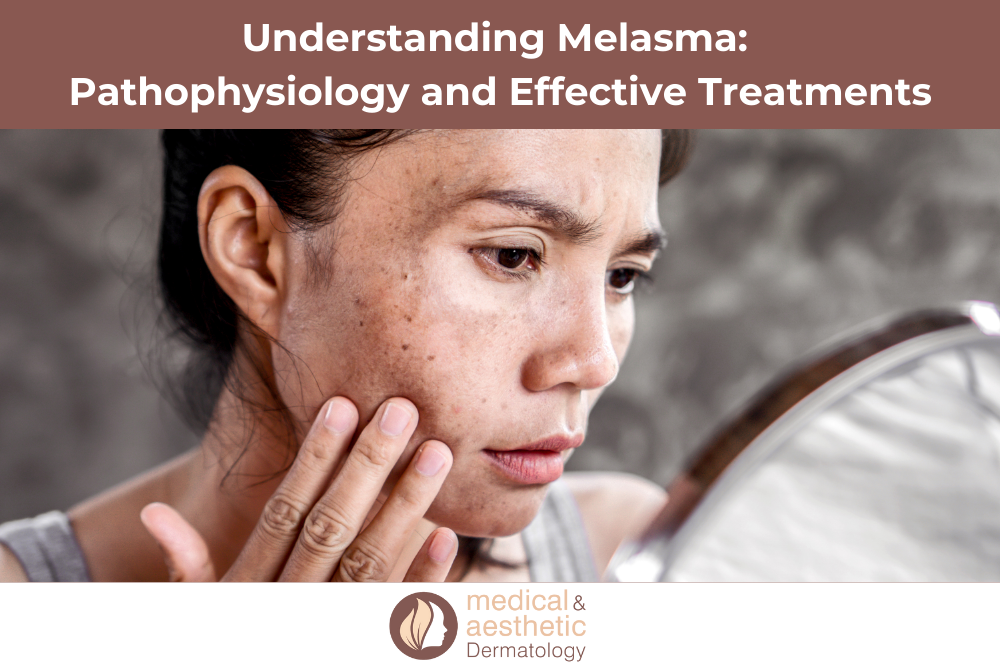 Melasma, a common skin condition, presents as brown or grayish-brown patches, usually on the face. It is a persistent condition that can significantly impact self-confidence, making effective management crucial. At Medical & Aesthetic Dermatology in Columbia, MD, we specialize in diagnosing and treating melasma using evidence-based therapies tailored to individual skin needs.
Melasma, a common skin condition, presents as brown or grayish-brown patches, usually on the face. It is a persistent condition that can significantly impact self-confidence, making effective management crucial. At Medical & Aesthetic Dermatology in Columbia, MD, we specialize in diagnosing and treating melasma using evidence-based therapies tailored to individual skin needs.
What Causes Melasma?
Melasma results from an overproduction of melanin, the pigment responsible for skin color. The exact cause remains unclear, but multiple factors contribute to its development, including:
- Hormonal Changes
Melasma is strongly linked to hormonal fluctuations, such as those during pregnancy, hormone therapy, or the use of oral contraceptives. This association is why it’s often referred to as “the mask of pregnancy.” - Sun Exposure
Ultraviolet (UV) radiation is a significant trigger. UV rays stimulate melanocytes (pigment-producing cells) to produce excess melanin, exacerbating melasma. - Genetic Predisposition
A family history of melasma increases susceptibility, particularly in individuals with darker skin tones, where melanocytes are more active. - Skincare Products and Medications
Certain cosmetics and medications can irritate the skin, triggering or worsening melasma.
Melasma Treatments: What Works?
At Medical & Aesthetic Dermatology, we offer a range of treatments tailored to manage melasma effectively.
1. Topical Treatments
- Hydroquinone: A gold standard for lightening melasma, hydroquinone reduces melanin production.
- Retinoids: These promote skin cell turnover, reducing pigmentation.
- Corticosteroids: Often combined with hydroquinone and retinoids for better results.
- Non-hydroquinone alternatives: Azelaic acid, kojic acid, and tranexamic acid are effective options for sensitive skin.
2. Chemical Peels
Chemical peels using glycolic acid or salicylic acid exfoliate the skin’s surface, reducing pigmentation. Regular sessions can significantly lighten melasma over time.
3. Laser and Light Therapies
Advanced technologies like fractional lasers and intense pulsed light (IPL) precisely target pigment without damaging surrounding skin. These treatments are performed with caution to avoid overstimulation of melanocytes.
4. Microneedling with Topicals
This minimally invasive treatment enhances the penetration of topical agents, improving their efficacy in treating melasma.
5. Sun Protection
Sunscreen is a non-negotiable in melasma management. A broad-spectrum sunscreen with SPF 30 or higher, preferably with physical blockers like zinc oxide or titanium dioxide, prevents further darkening.
6. Oral Medications
Oral tranexamic acid has emerged as a promising treatment for melasma. It works by reducing blood vessel activity linked to melanocyte stimulation.
The Role of Skincare in Managing Melasma
A gentle skincare routine is essential to prevent irritation and further pigmentation. Look for:
- Mild cleansers: Avoid harsh soaps or scrubs.
- Hydrating products: Support the skin barrier with ingredients like ceramides and hyaluronic acid.
- Antioxidants: Vitamin C and niacinamide help reduce pigmentation and protect against environmental damage.
Comprehensive Q&A
Q: Is melasma permanent?
A: Melasma can be persistent, but with consistent treatment and sun protection, it can be effectively managed and lightened.
Q: Can melasma occur on body parts other than the face?
A: Yes, melasma can appear on areas frequently exposed to the sun, such as the neck and forearms.
Q: How long does it take to see results from melasma treatment?
A: Results vary depending on the treatment, but noticeable improvements typically occur within 8-12 weeks of starting therapy.
Q: Are laser treatments safe for darker skin tones?
A: Yes, but they require expertise. At Medical & Aesthetic Dermatology, we use technologies tailored for diverse skin tones to minimize risks.
Q: Can melasma worsen during pregnancy?
A: Yes, pregnancy-related hormonal changes can exacerbate melasma. Treatments are usually limited during pregnancy, focusing on sun protection and gentle skincare.
Q: Can stress contribute to melasma?
A: Stress may indirectly influence melasma by disrupting hormonal balance, highlighting the importance of a holistic approach to management.
Trust the Experts at Medical & Aesthetic Dermatology
Melasma can be a challenging condition, but with the right treatment plan, it is manageable. Our team at Medical & Aesthetic Dermatology combines advanced dermatological expertise with personalized care to help you achieve clearer, healthier skin.
Contact Us
📍 Address: 9256 Bendix Road, Suite 200A, Columbia, MD 21045
📞 Phone: (443) 542-0505
Schedule your consultation today and take the first step toward radiant, even-toned skin!

